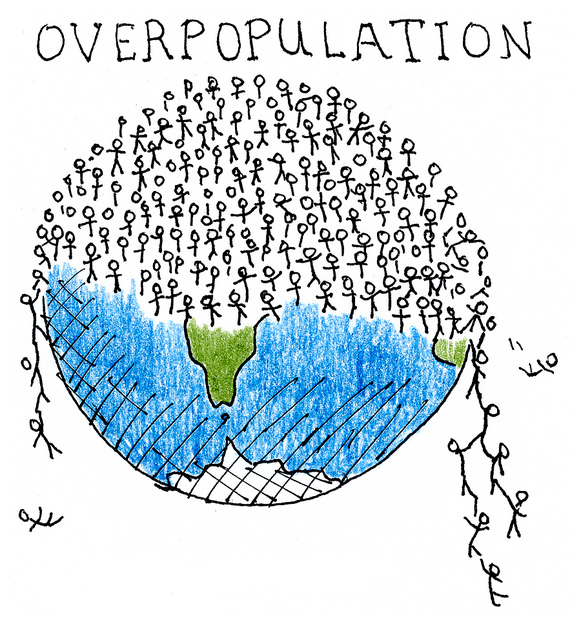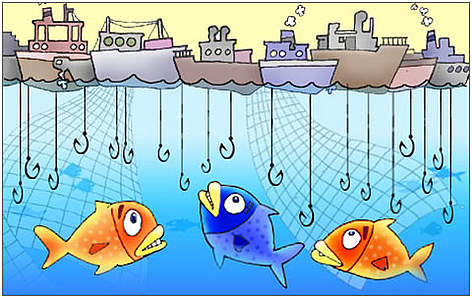Population Stabilization No Quick Fix for Environmental Crisis – That’s One Reason it’s Often Overlooked as a Solution
Published on November 19th, 2014
A study recently published in the prestigious scientific journal Proceedings of the National Academy of Sciences (PNAS) has generated a lot of media buzz, but for the wrong reason.
The study, by ecological researchers Corey Bradshaw and Barry Brook at the University of Adelaide in Australia, is entitled “Human population reduction is not a quick fix for environmental problems.”
 In a sense, it merely confirms the obvious: that reducing the massive and biosphere-devouring impacts of 7.2 billion humans on Earth to acceptable levels cannot happen fast enough by voluntary and humane means alone. This is because population size and related impacts change more slowly and ponderously than what is needed to meet the multiple pressing environmental crises we face.
In a sense, it merely confirms the obvious: that reducing the massive and biosphere-devouring impacts of 7.2 billion humans on Earth to acceptable levels cannot happen fast enough by voluntary and humane means alone. This is because population size and related impacts change more slowly and ponderously than what is needed to meet the multiple pressing environmental crises we face.
As the PNAS study states:
The planet’s large, growing and overconsuming human population, especially the increasing affluent component, is rapidly eroding many of the Earth’s natural ecosystems. However, society’s only real policy lever to reduce the human population humanely is to encourage lower per capita fertility. How long might fertility reduction take to make a meaningful impact? … Because of … demographic momentum, there are no easy ways to change the broad trends of human population size this century.
Scientific American quoted the study’s lead author Corey Bradshaw: “I hope this is taken as a wake-up call and a sobering reminder of how long we’ve neglected the population issue.”
 Yet this is not at all how the mainstream media chose to interpret – or misinterpret – the study. Typical was a grossly misleading headline for a blog post by environmental reporter Chris Mooney in one of the nation’s leading newspapers of record, The Washington Post: “Stop pretending we can fix the environment by curbing population growth.”
Yet this is not at all how the mainstream media chose to interpret – or misinterpret – the study. Typical was a grossly misleading headline for a blog post by environmental reporter Chris Mooney in one of the nation’s leading newspapers of record, The Washington Post: “Stop pretending we can fix the environment by curbing population growth.”
The implication of that headline, of course, is that promoting birth control and family planning is pointless, and has no place in the race to save Mother Earth from the excess and excesses of her Prodigal Son (and Daughter). While the article itself was more nuanced, the takeaway for many readers was undoubtedly that population is not an important or legitimate environmental issue, exactly the opposite effect of what the PNAS study authors intended.
It’s a prime example of how fraught and sensitive the population issue is. Those of us who deal with population, and the even more hot-button immigration issue, know what it is to have our words pounced on, twisted or taken out of context by those ever ready to smear us and our cause.
Another way of expressing what the PNAS authors meant was that long-term human population stabilization and/or reduction is an absolutely necessary – albeit far from a sufficient – condition to conserving the biosphere and pursuing long-term environmental sustainability.
The right approach to these issues is suggested by a joint effort now being undertaken by the Population Reference Bureau (PRB) and the Worldwatch Institute to both empower women and preserve the environment. PRB and the Institute recently started a joint working group of health, climate and population experts from around the world. This group is preparing a report on how to integrate family planning into governments’ environmental policies.
|
|
| Too many people chasing too few fish |
As Alexander Ochs, director of the Worldwatch Institute’s Climate and Energy Program, says, controlling fertility not only improves maternal and child health and welfare but conserves natural resources as well.
In its most recent report, the Intergovernmental Panel on Climate Change (IPCC) admitted that a growing global population is one cause of increased greenhouse gas emissions and intensified global warming. The IPCC cited one study estimating 30 percent lower emissions by 2100 if barriers to providing women with birth control could be overcome.
Yet in spite of what all too many shallow politicians, environmentalists and reporters seem to realize, climate change is not the only environmental problem of concern, and it is certainly not the only one exacerbated by large and growing human populations.
Overpopulation also aggravates soil erosion, paving of farmlands, urban sprawl, water shortages, air and water pollution, overfishing, dead zones in lakes and marine settings, deforestation, disappearing wildlife, increasing extinctions, loss of wildlife habitat and wilderness, traffic congestion, fossil fuel depletion, and the assault on natural beauty because of ever more manmade clutter filling up the landscape.
While limiting human population may not ensure a quick fix to any of these, not limiting population ensures certain failure.





